Okinawa Kayak trip, Summer 2006, Part2

The next day is windy and waves are breaking on the reefs, but the typhoon has moved off fast and things are only going to get better, so there is no reason to stick around. Although all ferries and flights in the area have been cancelled, we make fairly quick work of traversing the 20km or so northwest to Tonaki Island. A wild, cliffy coast greets us and running the reef on the way to port we disturb the slumber of no fewer than six enormous sea turtles.
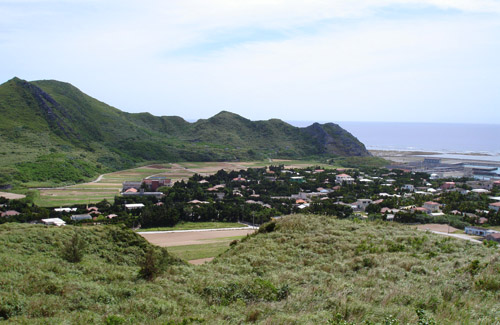
Tonaki is quite small and has mountains in the north and south, while a saddle shaped depression in the middle is home to its only village and a few sandy fields. This wind-tunnel topography makes typhoons doubly formidable here: all flat land is exposed. From a hilltop viewpoint the town seems so isolated and desolate, so utterly surrounded by the vast sea. But the folks that live here know how to tough it out and today, the day after a typhoon, everyone is lively.
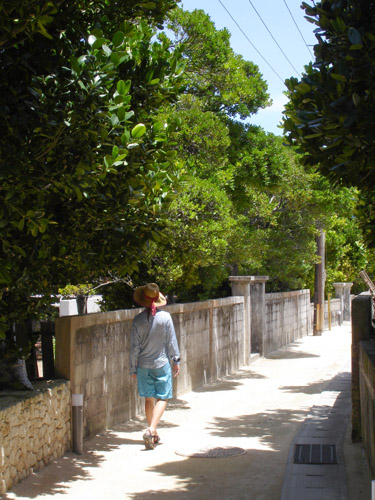
Over time stone walls and live walls of dense trees have been established so that the whole village is enveloped in their quiet shadows and it is a pleasure to walk through on a hot summer day.
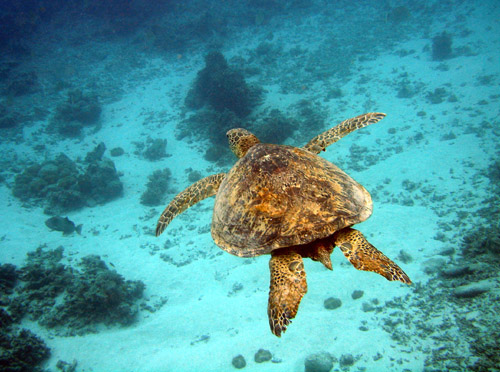
It is only a short walk from the port to the sea on the other side of the island, where the reef looks most inviting for diving, so we grab our snorkel gear. We have to swim out almost a kilometer before we reach the reef’s edge, but are rewarded with sights of many fish, sea turtles, and even a shark.
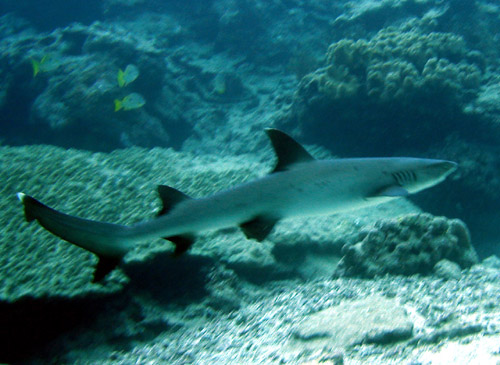
We want to see more, but are driven back by an isolated thundershower. Walking back in the warm rain, we spy the town office. Our cell phone won’t work here, so we go in to ask if we can use their Internet to check the weather. Inside we behold a bizarre sight: at least a dozen people shuffling papers, sitting behind computers, stacks and stacks of papers everywhere – is this really what it takes to administer a village of a couple hundred people? Many computer screens flicker familiar Internet images, but of course our humble request to use one of them for a couple of minutes is flabbergasting. Eventually we get our way. Still dripping wet from the sea and rain, we begin to freeze in the over-air-conditioned space, and are relieved to exit back into the damp heat, a printout of a fresh weather forecast in hand.
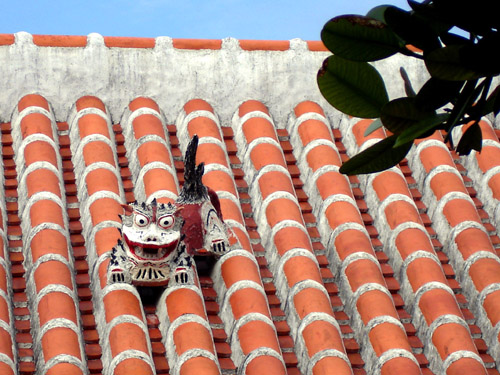
Guardian lion dogs known as shiisaa decorate the roofs of most houses
Only two tiny, under-stocked stores are to be found on the island. Where do people get their food? We seek dinner at the only “restaurant”, that is, a sign in front of a permanently parked mini-truck that now seems to serve as a home proclaims that one can eat food here. The occupant, a middle-aged woman, seems quite surprised to see us, but serves us a simple, delicious meal. We’re in no hurry and she’s quite eager to talk, so we also order shaved ice with strawberry syrup and sweetened condensed milk. Originally from Osaka, she had moved here many years ago with her father, and when a typhoon promptly destroyed their home, she never found enough money to build a new one. Now she ekes out a living growing millet, patiently waiting till she’s old enough to go on government pension. She tells us about other kayakers who ate here last year; they had a similar itinerary and were evidently her last customers before we showed up! So she was quite surprised, so sorry. Definitely not enough tourists here to make a living running a restaurant, though people try from time to time, she said. I wonder to myself: why are people who live in these kinds of places so candid? Normal Japanese are so painfully plagued with a certain sense of shame and embarrassment; this makes interesting casual conversation just about impossible. Certainly they wouldn’t share such honest life stories with strangers.
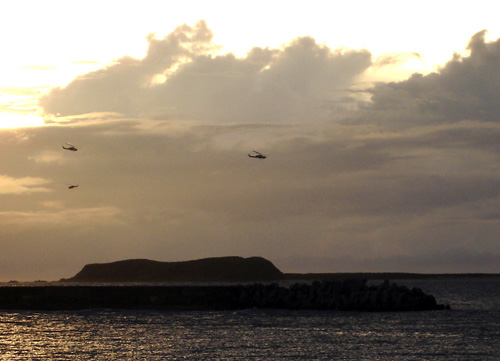
Loitering about town, we end up at the ferry terminal where we discover a startling fact: Tonaki’s satellite island, Irisuna-jima, which seemed up to now an ideal camping spot, is actually a shooting range for the Japanese military. Had it not been for the accidental sign showing an unusually accurate chart of the ferry’s route (which carefully skirts said area), and our equally accidental visit to this deserted-looking building, we may well have soon been on the way there! And sure enough, a brace of helicopters appears overhead and begins to blast the island, first with rockets (!!) then more conventionally with large caliber machine guns. Smoke and plumes of sand rise from the beach as we watch the spectacle with binoculars; somehow the feeling is like watching a tag team of grade school bullies beating up on a defenseless, nerdy kid. An impressive display of power for a country whose constitution explicitly prohibits a military establishment!
Our own strategic camping possibilities thus restricted, we peruse the weather forecast and conclude we have to depart as soon as possible. In two days the wind is to shift to the northeast and strengthen, and we have several long crossing to make in that direction. Thus we grab two or three hours of sleep at the port (it’s just about too hot to sleep anyway) and at midnight set out on our next crossing: about 30km westward to Kume-jima. In the darkness, we too skirt the military zone though it adds distance; last thing we feel like doing is dodging bombs in the middle of the night. Altogether the crossing goes smoothly though unexpected currents occur and kick up waves here and there. Rather than fighting the current we allow ourselves to be carried north slightly. 10km before Kume-jima a lighthouse on a reef serves as a landmark; from here the reef stretches all the way ahead. Once past the lighthouse we attempt once to enter the lagoon inside the reef but in the dark it’s too risky, so we paddle alongside, in deep water. At least the reef had cut off most of the waves. By dawn we are finally able to cross and sunrise finds us on the beach at Ooha-jima, an outlying islet. We had made good time but we are sleepy and tired. We grab a nap under some pine trees, not minding ants and crabs crawling all over us, but in about an hour it gets too hot to sleep, so we move on.
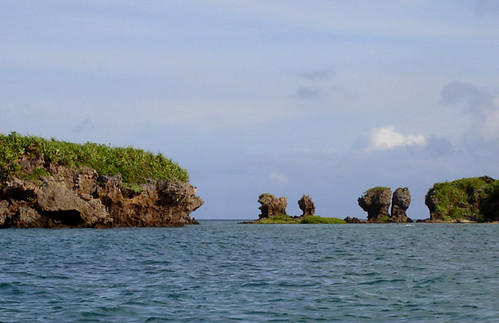
Ichunza rocks near Kume Island


0 Comments:
Post a Comment
<< Home